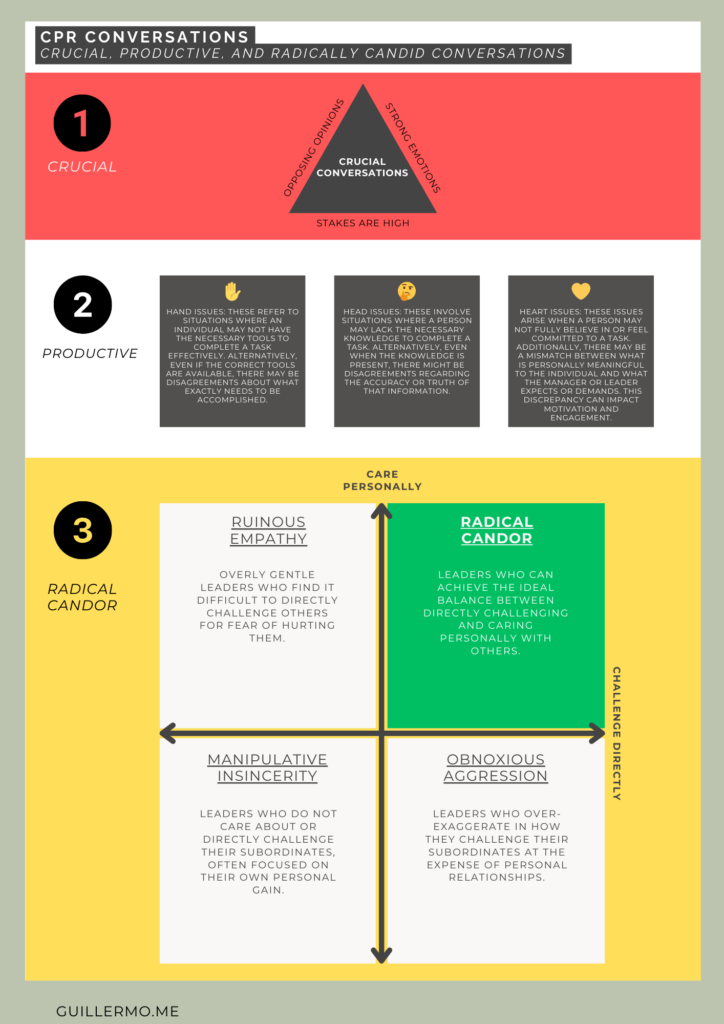I have held many leadership roles in the past and present, where the necessity for crucial conversations became apparent. These vital discussions have spanned various areas of my life, including professional settings, business environments, church activities, and personal relationships. Such conversations are crucial because failing to have them can significantly impact your employment, business operations, organizational dynamics, and even personal life. These are often referred to as “crucial conversations.”
In the book Crucial Conversations, the authors define such a dialogue as one involving opposing opinions, strong emotions, and high stakes. Identifying conflicts where these elements coexist necessitates having the conversation.
Kim Scott provides further insights in her book Radical Candor. She explains that avoiding these necessary conversations and ignoring the proverbial elephant in the room is both unkind and irresponsible. She asserts,
“From the time we learn to speak, we’re told that if you don’t have anything nice to say, don’t say anything at all. While this advice may work for everyday life, it is disastrous when adopted by managers… because now it’s your job to say it.“
Buster Benson, in his book Why Are We Yelling? The Art of Productive Disagreement, suggests that conflicts do not have to be negative. Effectively managed, they can enhance relationships, resolve issues, and spark innovative ideas. He believes,
“Disagreements are a sign of group health, not pathology, and cultures that address grievances productively are more likely to foster successful relationships, businesses, and communities.”
So, how do we engage in crucial conversations, productive disagreements, and radically candid discussions?
Drawing from these three authors, as well as my own experiences and errors in business, church leadership, professional management, and personal life, I have developed a framework that improves communication in these areas.
I refer to this approach as CPR Conversations—a model informed, inspired, and developed based on the insights of the aforementioned authors. CPR stands for Crucial, Productive, and Radically Candid conversations, encapsulating all three essential elements. Here’s why each component is vital:
C — Crucial Conversations: Defined by; Opposing Opinions, Strong Emotions, and the Stakes are High. This is about determining the necessity of a conversation. However, a crucial conversation isn’t inherently productive. Engaging only in crucial conversations without aiming for productivity and candor can lead to wasted efforts and potential harm.
P — Productive Disagreements: This involves identifying the type of conversation needed. This recognition can guide you toward making the discussion productive rather than merely crucial. Yet, a productive conversation does not automatically mean it is radically candid.
R — Radically Candid Conversations: This concept requires you to care personally and challenge directly. When both elements are active, it epitomizes Radical Candor, the most effective approach for advancing both organizational goals and personal relationships.
When Crucial, Productive, and Radical Candor all align, it truly represents the best method for engaging in meaningful conversations.
Here’s a more detailed explanation of the framework.
Step 1
Is there a need for a conversation? Is it crucial? Identify whether a Crucial Conversation needs to be had. Crucial Conversations are defined by: Opposing Opinions, Strong Emotions, and the Stakes are High. If all those are true, then a conversation is essential.
- If no, refrain from jumping to conclusions or engaging in unnecessary discussions that could exacerbate a non-issue.
- If yes, then move to the second step.
Step 2
What type of conversation is needed for it to be productive? Identify what kind of conversation is needed. Buster Benson realizes that there are three types of issues we usually come across when having a disagreement with someone; the Hands, Head, and Heart.
- ✋ Hand Issues: These refer to situations where an individual may not have the necessary tools to complete a task effectively. Alternatively, even if the correct tools are available, there may be disagreements about what exactly needs to be accomplished.
- 🤔 Head Issues: These involve situations where a person may lack the necessary knowledge to complete a task. Alternatively, even when the knowledge is present, there might be disagreements regarding the accuracy or truth of that information.
- 💛 Heart Issues: These issues arise when a person may not fully believe in or feel committed to a task. Additionally, there may be a mismatch between what is personally meaningful to the individual and what the manager or leader expects or demands. This discrepancy can impact motivation and engagement.
Step 3
Have a Radically Candid Conversation: Radical Candor happens when you Care Personally and Challenge Directly. Use the following Radical Candor quadrant framework.
Axes Labels:
- Vertical: Care Personally
- Horizontal: Challenge Directly
Quadrants:
- Top Right – Radical Candor
- Description: Leaders who can achieve the ideal balance between directly challenging and caring personally with others.
- Top Left – Ruinous Empathy
- Description: Overly gentle leaders who find it difficult to directly challenge others for fear of hurting them.
- Bottom Right – Obnoxious Aggression
- Description: Leaders who over-exaggerate in how they challenge their subordinates at the expense of personal relationships.
- Bottom Left – Manipulative Insincerity
- Description: Leaders who do not care about or directly challenge their subordinates, often focused on their own personal gain.
Finally, I leave you with a visual of all these elements:

PS. This post says nothing about Biblical principles undergirding this framework. For a theological perspective on this topic, click here.
